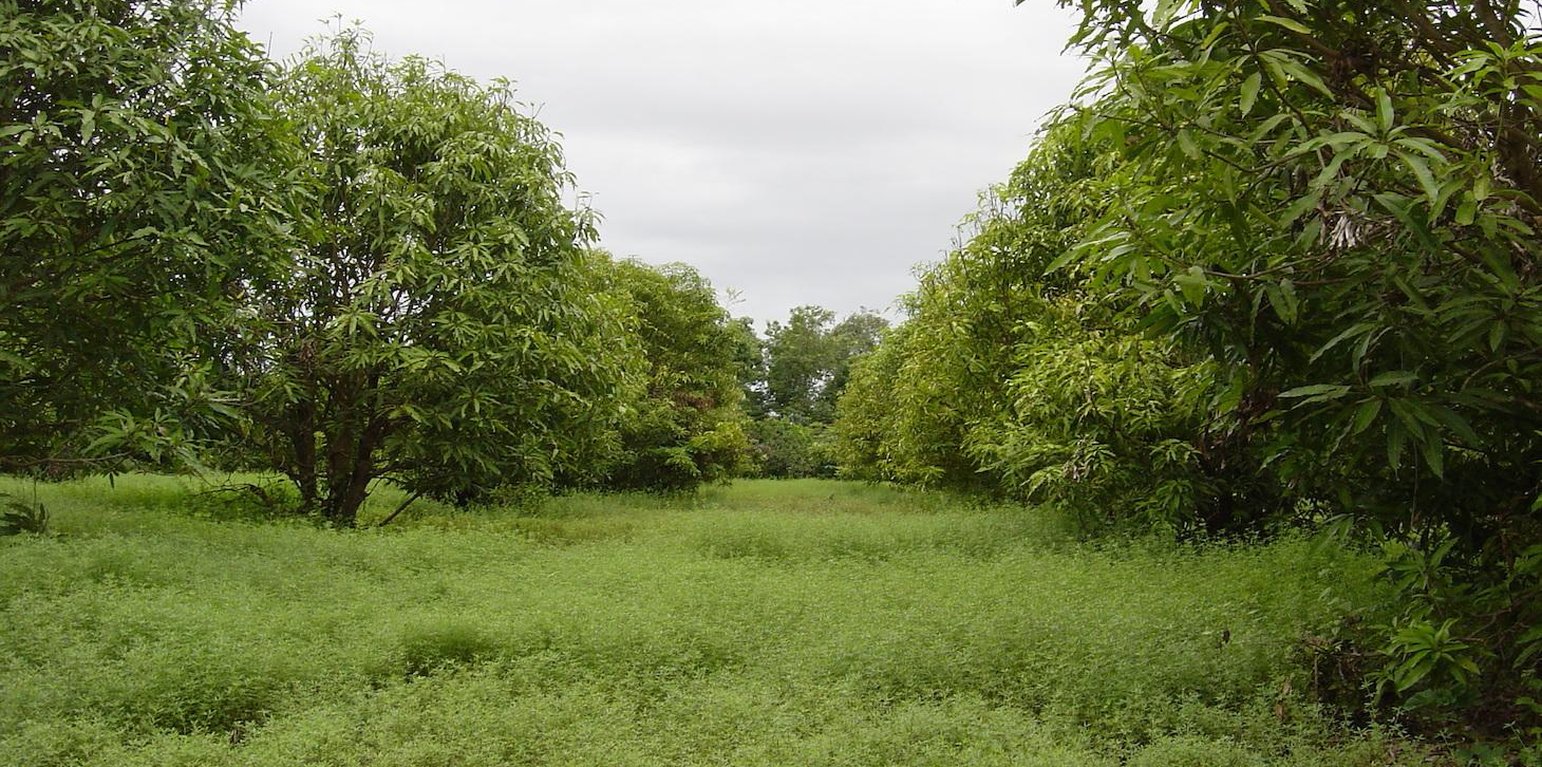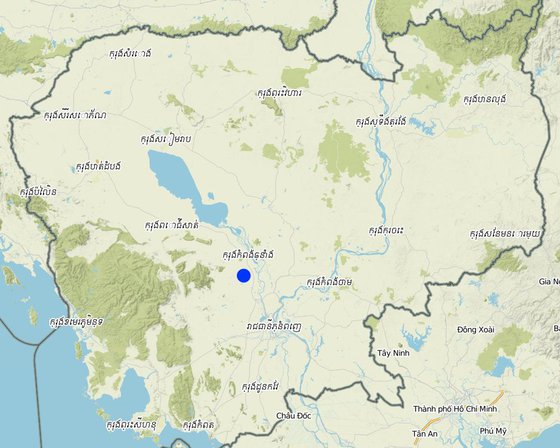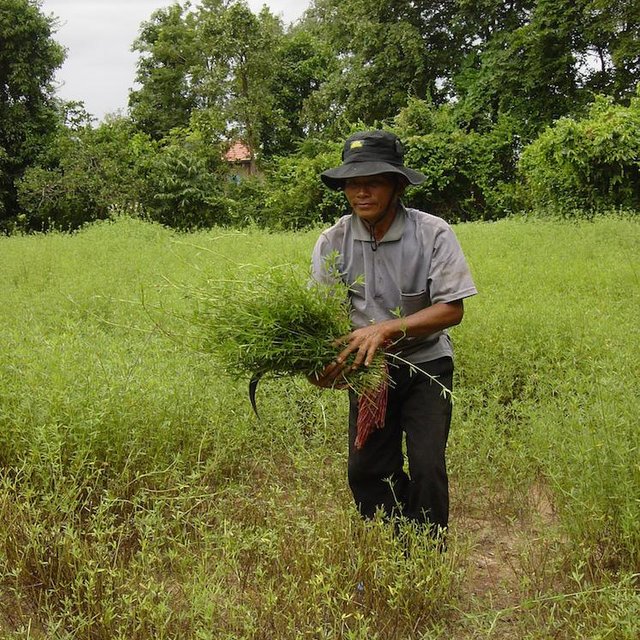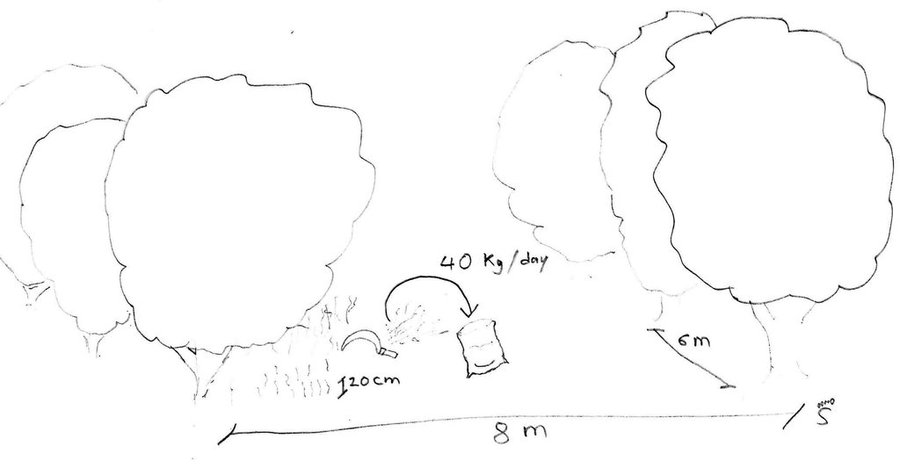



Stylo grass (Stylosanthes guianensis, CV. Stylo 184) is a leguminous shrub which is used in pastures and as fodder crop. It is drought tolerant and can be harvested during the whole year, though it grows only when sufficient water is available. Mangos (Mangifera indica) are grown mainly from seeds in the area, either as single trees in home gardens or as orchards. The farmer of this case study has a mango orchard of 0.6 ha with trees spaced 6 by 8 meters, and grows stylo grass as a cover crop under and between the trees. Each day a patch of stylo grass is harvested by hand, and around 40 kg of this fodder is fed to the cattle together with rice straw. This allows the farmer to keep more cattle than before, 11 heads instead of 5. The mangos are mainly sold on the market, and some are dried. This agroforestry system reduces erosion by wind and water, as the soil is covered the whole year and the trees slow down the wind. The cattle can be kept near the house, which is good for making compost and biogas.
In 2004, the farmer cleared a forest and planted mango seedling. Between the mangos, he grew pumpkins, watermelons and cucumbers, but even though he used compost the soil fertility deteriorated fast and the cucurbits did not produce anymore. A local NGO, LAREC (Local Agricultural Research and Extension Centre), was looking for farmers with enough cattle and land in the area to try stylo grass, which was unknown in the area. The farmer, first reluctant because his other crops were not producing, started to plant stylo grass seeds he got from the NGO in July 2013 (information for this documentation was collected one year after the start).To do so, he plouwed and harrowed the fields with the hand tractor, and broadcasted the seeds by hand. After the first 3 months, during which he needed to weed, he started harvesting the fodder, and he cut 40 kg a day, one patch after another, 20 cm from the soil. This allows the reproduction of this cover crop.
The land user wants to expand his stylo grass to his other mango orchard, and is collecting seeds for this. Other farmers in the area are also interested in this technology; and the land user of this case-study starts to sell them stylo grass seeds but does not produce enough for all yet.
The analysed area is mostly flat (slope < 2%), tropic (dry and wet season), and the soils are mostly sandy or loamy. The soils contain little organic matter (low soil fertility, acidification, small amount of cattle, area has been deforested) and the groundwater table is rather high (3 m below soil level during the dry season, on the surface during the wet season).
Due to climate change, the rainfalls are more erratic, temperatures rise and droughts are more recurrent. Rice is the predominant crop grown in the area, since it serves as staple food (mix subsistence and commercial activities). Rice is often grown in monocultures and harvested once a year. Once the rice is harvested (dry season), some farmer release cattle to the paddy fields to eat the straw and weeds.
As an addition to rice, most land users grow vegetable and fruits in small home gardens (subsistence) and complement their income by producing handicrafts or through off farm income / remittances from family members working in other places. The increasing migration rate (the young generation leaves the villages to work in the cities, garment industry or abroad) results in a decrease of available labour force in the area which has detrimental effects on the agricultural activities. Furthermore, the civil war in the 1970s (Khmer Rouge) led to the loss of agricultural knowledge which different NGOs try to re-establish.

Localização: Sre Ouk Samlor Sap/Taing Krasaing/Rolear Pha,er, Kampong Chhnang, Camboja
Nº de sites de tecnologia analisados:
Difusão da tecnologia: Uniformemente difundida numa área (0.006 km²)
Em uma área permanentemente protegida?:
Data da implementação: menos de 10 anos atrás (recentemente)
Tipo de introdução







| Especifique a entrada | Unidade | Quantidade | Custos por unidade (n.a.) | Custos totais por entrada (n.a.) | % dos custos arcados pelos usuários da terra |
| Mão-de-obra | |||||
| Labour | ha | 1,0 | 21,25 | 21,25 | 100,0 |
| Equipamento | |||||
| machine use | ha | 1,0 | 100,0 | 100,0 | 100,0 |
| Material vegetal | |||||
| seeds | ha | 1,0 | 8,0 | 8,0 | |
| seedlings | ha | 1,0 | 200,0 | 200,0 | 100,0 |
| Fertilizantes e biocidas | |||||
| fertilizer | ha | 1,0 | 28,0 | 28,0 | 100,0 |
| Custos totais para a implantação da tecnologia | 357.25 | ||||
| Custos totais para o estabelecimento da Tecnologia em USD | 357.25 | ||||
| Especifique a entrada | Unidade | Quantidade | Custos por unidade (n.a.) | Custos totais por entrada (n.a.) | % dos custos arcados pelos usuários da terra |
| Mão-de-obra | |||||
| Labour | ha | 1,0 | 590,0 | 590,0 | 100,0 |
| Custos totais para a manutenção da tecnologia | 590.0 | ||||
| Custos totais de manutenção da Tecnologia em USD | 590.0 | ||||
Less time needs to be invested in harvesting wild grasses.
No wind erosion because of the soil cover, less water erosion.
Stylo gras is a leguminous, thus fixes nitrogen.
The mango leaves fall to the soil and increase the organic content.
The mango trees slow down the wind
The living fence was already planted before.